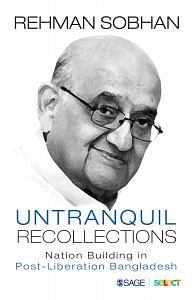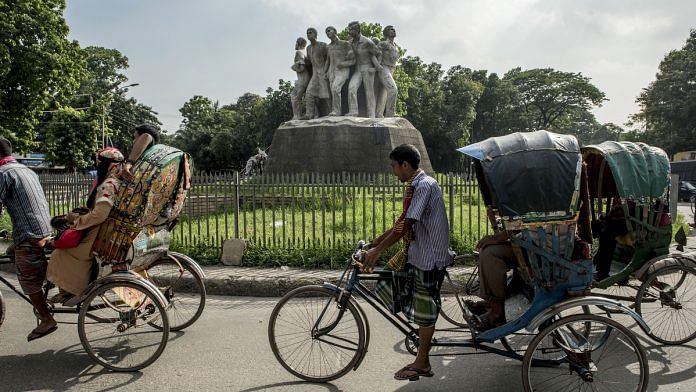I awoke on a cold New Year morning of 1972 with sunshine streaming through my windows, suffused with a sense of well-being and optimism. I was home in a liberated Bangladesh after nine months of tension and uncertainty where I had traversed the world as a soldier of Bangladesh with no expectation that I would arrive at journey’s end any time soon.
I was a guest at the home of my dear friend, Zeaul Haq (Tulu), and his wife Jolly on Road 20, Dhanmondi. They had taken me into their home the day before on my arrival from Kolkata in the company of our mutual friend Mosharraf Hossain. In these nine months, the Pakistan Army had invaded my home on Road 69, Gulshan, to arrest me. My wife Salma and our three sons, Taimur, Babar and Zafar, had narrowly avoided being held as hostages for my surrender before managing to get out of Pakistan and reach England where they had set up a transitional home in Oxford.
I had moved from Dhaka to Delhi via Agartala from where I had been sent off by an independent Bangladesh’s first PM, Tajuddin Ahmad, to campaign abroad to withhold foreign aid to Pakistan and to obtain recognition of our sovereignty from the world community.
We began New Year’s Day with one of Jolly’s epic breakfasts which had been served and she continued to serve over the years as a welcoming aperitif for many historic encounters.
In the fortnight since the surrender of General Niazi at the Race Course Maidan, the country was living through a twilight phase. Some of the leaders of the post-liberation government had been flown into Dhaka on the same Indian Air Force Dakota which had recently landed Mosharraf and me in Dhaka. The Cabinet was installed in what is now Bangabhaban but which at that stage was a shell-struck, derelict mausoleum with gaping holes in the roof through which the sun streamed down on visitors. Syed Nazrul Islam, the acting president; Tajuddin Ahmad, PM; Mansur Ali; Abdus Samad Azad and even Khondaker Mostaq Ahmad, who had been removed from his position as foreign minister in the Mujibnagar government but remained a minister in the first Cabinet, were in residence and had been joined by Qamruzzaman who had accompanied me on the flight from Kolkata the day before.
Also read: When celebrating 50 yrs of 1971 War, don’t forget this life-saving sachet and Bengali doctor
These six ministers, who together constituted the first Government of Bangladesh, were attempting to establish their authority over a war-devastated, traumatized nation with no functioning administration, police force or budgetary resources to underwrite their government. In these circumstances, the government needed to work in close harmony. Whilst the Tajuddin-led Cabinet provided the formal authority, particularly in dealing with India, the five leaders resident in Bangabhaban had constituted their own centres of power. Within their respective fiefdoms, each minister received those personally loyal to them, made decisions which lay within their authority and dispensed what patronage was available to them without reference to the PM. Tajuddin made some attempt to restore coherence in the decision-making process. Some important decisions like the move to practise austerity by imposing a ceiling of Tk.1000/00 on salaries of all public servants were taken by the Cabinet.
The Indian government had dispatched a large mission to identify the government’s resource and administrative needs. Qamruzzaman had, from his Mujibnagar days, been assigned the portfolio of rehabilitation and was authorized to interact with the Indians. In the weeks prior to liberation, the Planning Board, under the leadership of Mosharraf Hossain, had worked with Qamruzzaman to prepare a draft of a rehabilitation plan which was used as a basis for discussion with the visiting mission from India. Such initial actions by the government in place in Bangabhaban left much ground uncovered so that the basis of a functioning administration still remained some distance away.
Within this emerging vacuum in governance, alternative centres of power were moving in to fill the spaces. Much of
Bangladesh still remained a no-man’s land with more sinister manifestations of anarchy emerging in the shape of what came to be known as the 16th Division. This was made up of armed youth of uncertain antecedents, claiming to be mukti juddhas (freedom fighters), who were taking over vacant houses, hijacking cars and extorting money at gunpoint from unwary citizens.
In Iqbal Hall at Dhaka University, a centre of power had emerged, constituted around the four student leaders from the Chhatra League—Abdur Rab, vice-president of Dhaka University Central Students’ Union; Shahjahan Siraj, its general secretary; Nur-e-Alam Siddique, president of the Chhatra League (CL) and Abdul Quddus Makhan, its general secretary. Termed popularly as the four caliphas, they had already established their own autonomous administration. They had their own bahini (fighting force) exercised power and disbursed patronage as they saw fit. The caliphas were not organized or cohesive enough to enforce discipline on the large numbers of armed youth who engaged in various forms of private brigandage using the cover of the caliphate in Iqbal Hall.
Also read: 1971 to 2021 – We fought together, now Bangladesh Army marches with us on Republic Day
Apart from the four caliphas who remained an autonomous entity of their own, at another location, the Mujib Bahini, a well-armed military formation, led by Sheikh Fazlul Haque Moni, nephew of Bangabandhu, along with CL leaders—Sirajul Alam Khan, Abdur Razzaq and Tofail Ahmed—provided yet another centre of power. This formation had been specially trained by the Research and Analysis Wing (RAW), a special force of the Indian intelligence agency under the direction of Major General Sujan Singh Uban, as a prospective counterforce to what was apprehended to be the more radicalized insurgents active in the liberation struggle outside the discipline of the Mukti Bahini. As it transpired, the Mujib Bahini became more of a problem for the high command of the Mukti Bahini since they operated through their own independent chain of command.
It is not clear how effectively the Mujib Bahini used their better quality of weaponry to fight the Pakistan Army but in the post-liberation period, their military capability was perceived as a challenge to the authority of the post-liberation government.
Whilst none of those emerging centres of power had as yet begun to overtly challenge the authority of what was formally recognized as the Government of Bangladesh, the passage of time was expected to expose its administration to more serious contestation.
The nights in Dhaka had become a fraught moment where people preferred to lock themselves at home or moved around within their own neighbourhood. The areas outside Dhaka remained even more uncertain areas of darkness. There were as yet no functioning agencies of law enforcement to whom one could turn for protection from acts of extortion and violence.
In such circumstances, it says much for the shared sense of patriotism generated by our liberation and the sense of self-discipline not just of our citizens but most of those who had taken up arms that some elements of normalcy prevailed in those fraught days. People had begun to go about their business until such time as they may personally be exposed to some threat to their security.
The task of establishing a coherent administration was complicated by the arrival of those who had constituted the machinery of administration in the Mujibnagar government in Kolkata. The migrant officers were led by officials who had, during the last days of united Pakistan, been serving as district administrators in the border areas of Bangladesh.
Most of the officers serving in these areas crossed the border into India and helped to constitute the core of the Mujibnagar administration. These not very senior officers, who had emerged as the first servants of the Republic, had expectations of higher responsibility in a liberated Bangladesh.
Also read: Indians should thank these three men for bringing 1971 Bangladesh ‘genocide’ to light
The 10 days of 1972 after my return to Dhaka were something of a twilight phase in our nation’s history. The attention of everyone in Bangladesh and perhaps also in some of the major capitals of the world was centred around the fate of one man, Bangabandhu Sheikh Mujibur Rahman, then held in captivity in Mianwali Jail in Pakistan. The people of Bangladesh had no knowledge of his fate or whereabouts but hoped and assumed, more on faith than evidence, that he was alive and would soon return to Bangladesh.
What they did not know was that Bangabandhu had already been released from Mianwali Jail and brought to an official guest house in Sihala near Rawalpindi on 26 December under the orders of Bhutto who had recently taken over as president of Pakistan. After 16 December and the surrender of Lt General Niazi at the Dhaka Race Course Maidan, Pakistan entered into a state of political turmoil. The emergence of an independent Bangladesh and the humiliation of their military defeat in Bangladesh had put the Pakistan armed forces in a mutinous mood against the military and political leadership of Yahya and his military accomplices.
Bhutto was under pressure from some global leaders to release Bangabandhu.
The uncertainty of Bangabandhu’s fate thus kept Bangladesh in a state of tension and its then government in limbo. While important decisions were taken by the Tajuddin government to establish its writ across the land, there was an air of provisionality about the government which tended to weaken its authority and constrained more decisive actions needed to restore greater normalcy to public life.
 Excerpted with permission from ‘Untranquil Recollections: Nation Building in Post Liberation Bangladesh’ by Rehman Sobhan, published by SAGE Publications India.
Excerpted with permission from ‘Untranquil Recollections: Nation Building in Post Liberation Bangladesh’ by Rehman Sobhan, published by SAGE Publications India.



